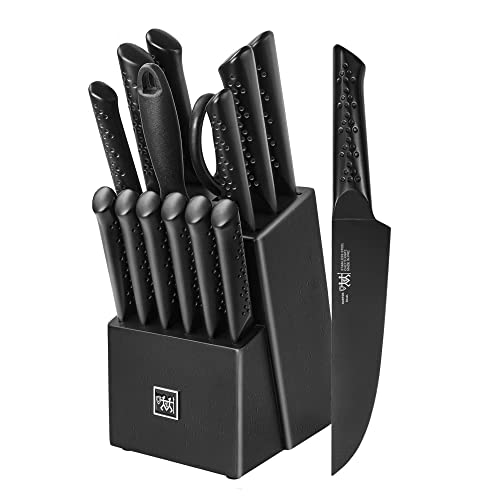knife: A chef’s knife is an essential tool in any kitchen, and one that every serious cook should have in their collection. With its long, wide blade and sharp edge, a good chef’s knife can make quick work of everything from chopping vegetables to slicing through tough cuts of meat. In this article, we’ll explore the history of the chef’s knife, what to look for when buying one, and how to care for and use it properly.
History of the Chef’s Knife
-
 Knife Set, HUNTER 15-Pc knife sets for kitchen with block, Black Kitchen Knife Set,Dishwasher Safe German Stainless…$69.99
Knife Set, HUNTER 15-Pc knife sets for kitchen with block, Black Kitchen Knife Set,Dishwasher Safe German Stainless…$69.99 -
 Aroma House Damascus Chef Knife 7.5″, Kitchen Gadgets, German HC Stainless Steel Cooking Knife with Pakkawood Handle, Premium Magnetic Gift Box,Great Gift Choice.$19.95
Aroma House Damascus Chef Knife 7.5″, Kitchen Gadgets, German HC Stainless Steel Cooking Knife with Pakkawood Handle, Premium Magnetic Gift Box,Great Gift Choice.$19.95 -
 HexClad 6 Piece Essential Kitchen Knife Set Full Tang Japanese Damascus Stainless Steel Knife with Pakkawood Handle…$349.99
HexClad 6 Piece Essential Kitchen Knife Set Full Tang Japanese Damascus Stainless Steel Knife with Pakkawood Handle…$349.99
The chef’s knife has been around for centuries, and its design has evolved over time to suit the needs of cooks and chefs around the world. The first chef’s knives were likely developed in Europe, where butchers needed a tool that could be used for both chopping and slicing meat. These early knives had long, narrow blades and a sharp edge that could easily cut through tough cuts of meat.
As cooking techniques evolved and became more sophisticated, so too did the chef’s knife. In Japan, for example, the Santoku knife was developed in the mid-20th century as a response to the increasing popularity of Western-style cooking. This knife features a wider, shorter blade than traditional Japanese knives, which makes it easier to chop and slice vegetables and other ingredients.
Today, the chef’s knife is an essential tool in kitchens around the world, from professional restaurants to home kitchens. While the basic design of the knife has remained the same, there are many variations and styles available to suit different cooking styles and preferences.
Choosing a Chef’s Knife
When choosing a chef’s knife, there are several factors to consider, including the blade material, handle design, and overall size and weight.
Blade Material
The most common materials used for chef’s knife blades are stainless steel and high-carbon steel. Stainless steel is durable and easy to care for, but it can be more difficult to sharpen and may not hold an edge as well as high-carbon steel. High-carbon steel, on the other hand, is sharper and holds an edge longer, but it requires more maintenance to prevent rust and corrosion.
Handle Design
The handle of a chef’s knife is also an important consideration. The handle should be comfortable to hold and provide a secure grip, even when your hands are wet or greasy. Many chef’s knives have handles made of wood, plastic, or composite materials. Wood handles are attractive and provide a good grip, but they can be more difficult to care for and may not be as durable as other materials. Plastic and composite handles are lightweight, easy to clean, and often more durable than wood.
Size and Weight
The size and weight of a chef’s knife can also affect its performance. A larger, heavier knife may be more efficient for chopping and slicing, but it may also be more tiring to use over long periods of time. A smaller, lighter knife may be easier to handle, but it may not be as efficient for larger tasks.
When choosing a chef’s knife, it’s important to consider your own preferences and cooking style. You may want to try out several different knives before making a final decision, to get a sense of which one feels most comfortable and natural in your hand.

Go to Our Shop Page Click Here
You can Hire freelancer : Click Here



